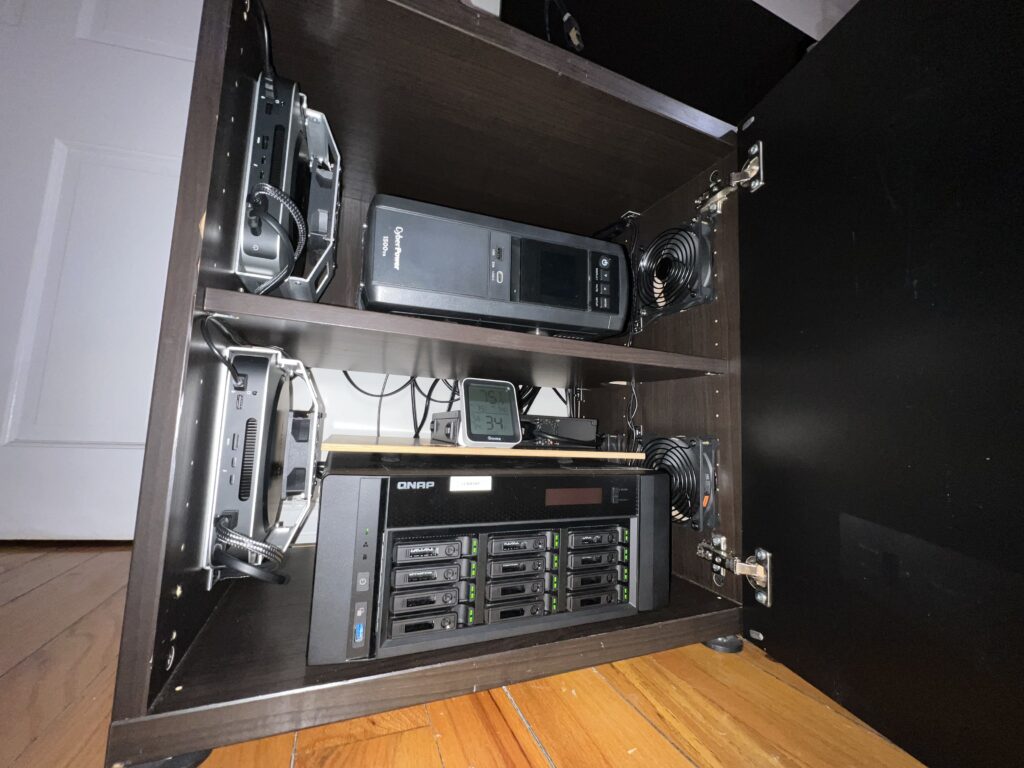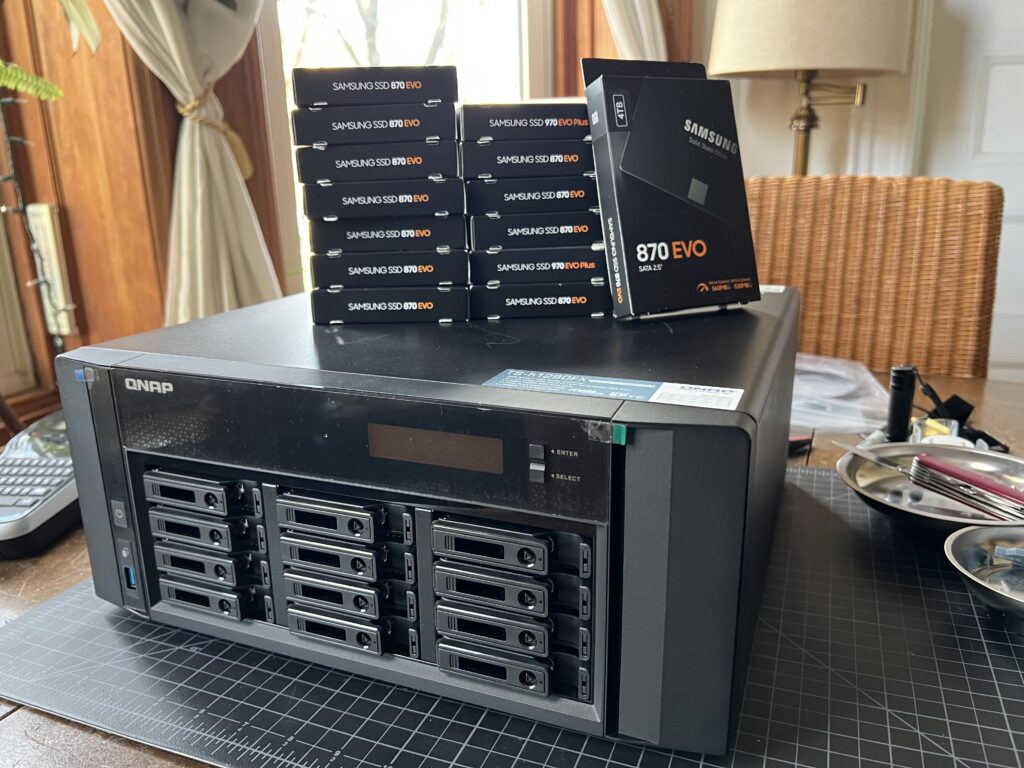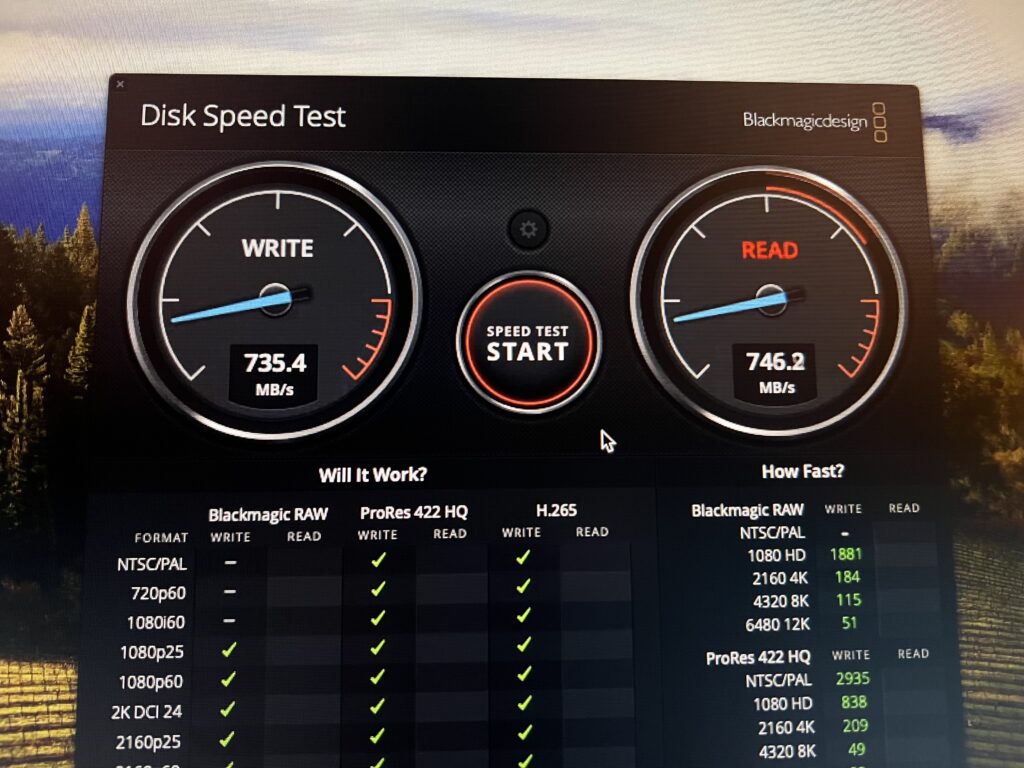I designed and implemented a sophisticated remote editing system for Living Legend Productions, transforming their workflow from shipping hard drives to a fully redundant, enterprise-grade remote post-production pipeline.

Custom furniture cabinet complete with UPS and fans
When Living Legend’s founders Rob Cristiano and Andy Fortenbacher approached me during the pandemic, they were facing a critical challenge that many production companies were encountering at the time: their traditional “JBOD” (Just a Bunch of Drives) workflow was creating bottlenecks in their post-production pipeline. With editors working remotely across the country, shipping hard drives overnight and attempting to upload massive video files to Google Drive, Drop Box or Frame.io wasn’t sustainable for their growing business.
Drawing from my experience as a technical consultant for post production in the film and television industries, I knew we needed a solution that would eliminate physical media transfers while preserving the workflows that their creative team had mastered. My relationship with Living Legend’s founders dated back to our collaboration on Columbia University graduate films, giving me unique insight into their production philosophy and needs.

120TB HDD NAS backup for Los Angeles office
I designed a system architecture centered around a high-performance solid-state drive network-attached storage (NAS) system QNAP TS-h1290FX, capable of serving multiple editors simultaneously working with mastering formats like ProRes 422 HQ and DNxHR 4K. Rather than having editors download massive files locally, I implemented a remote desktop solution using Jump Desktop, connecting editors to Mac Minis that accessed the NAS directly through a 10-gigabit network.
This infrastructure solved several critical challenges:
- Editors could work from anywhere with just a laptop and decent internet connection
- Assistant editors could prep projects remotely, ensuring everything was ready for editors to begin work immediately
- All media remained centralized, eliminating version control issues
- The system could easily scale to accommodate company growth
- Provided multiple layers of redundancy for disaster recovery


Security and redundancy were central to my design philosophy. I coordinated with cybersecurity consultants to protect their exposure landscape and architected a robust triple redundancy strategy: primary SSD NAS in Brooklyn, mechanical HDD backup NAS in Los Angeles, and cloud backup using AWS Glacier Flex. After evaluating multiple cloud storage options, I determined AWS Glacier Flex offered the optimal balance of cost-effectiveness and retrieval times for their specific needs.
To manage bandwidth efficiently, I developed a tiered access system. “Gold” members received full gigabit bandwidth for working with master-quality media, while “Purple” members utilized proxy workflows for more efficient remote editing. This hierarchical approach ensures that the system can scale smoothly as the company grows.

The success of this implementation wasn’t just in the technical architecture—it was in how seamlessly it integrated with Living Legend’s existing workflows. By maintaining familiar editing paradigms while modernizing the underlying infrastructure, I created a system that editors could adopt without a steep learning curve. After more than a year of operation, the system continues to perform flawlessly, enabling Living Legend to maintain their high production standards while embracing the advantages of remote work.
This project exemplifies my approach to technical consulting: understanding both the creative and technical demands of modern post-production, then designing systems that enhance rather than disrupt existing workflows. The solution not only solved Living Legend’s immediate challenges but created a more efficient, resilient, and scalable system that will serve their needs well into the future.

Mermaid Diagram of System
flowchart TB
subgraph Remote["Remote Editors & Assistant Editors"]
RE["Remote Editor Laptops"]
AE["Assistant Editor Laptops"]
end
subgraph NYC["Brooklyn Office Infrastructure"]
JD["Jump Desktop Gateway"]
SW["10Gb Switch"]
subgraph MM["Mac Mini Workstations"]
MM1["Mac Mini 1"]
MM2["Mac Mini 2"]
MM3["Mac Mini 3..."]
end
SNAS["Primary SSD NAS<br/>(40TB)"]
end
subgraph LA["Los Angeles Backup"]
HNAS["Mechanical HDD NAS<br/>(120TB)<br/>Daily Snapshots"]
end
subgraph Cloud["Cloud Backup"]
AWS["AWS Glacier Flex<br/>Archive Storage"]
end
subgraph BW["Bandwidth Tiers"]
GOLD["Gold Members<br/>1Gb - Full Quality"]
PURPLE["Purple Members<br/>Proxy Workflow"]
end
RE --> |"Remote Access"| JD
AE --> |"Remote Access"| JD
JD --> |"Remote Desktop"| MM
MM --> |"10Gb Connection"| SW
SW --> |"10Gb Connection"| SNAS
SNAS --> |"2Gb Fiber Sync"| HNAS
SNAS --> |"Backup"| AWS
classDef primary fill:#a8d1ff,stroke:#333,stroke-width:2px
classDef backup fill:#ffcccb,stroke:#333,stroke-width:2px
classDef remote fill:#d1ffcc,stroke:#333,stroke-width:2px
classDef network fill:#ffe0b2,stroke:#333,stroke-width:2px
classDef tier fill:#e1bee7,stroke:#333,stroke-width:2px
class SNAS primary
class HNAS,AWS backup
class RE,AE remote
class JD,SW network
class GOLD,PURPLE tier
